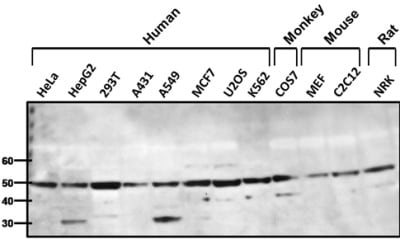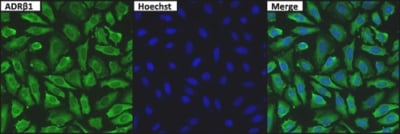Anti-beta 1 Adrenergic Receptor antibody (ab3442)
Key features and details
- Rabbit polyclonal to beta 1 Adrenergic Receptor
- Suitable for: ICC, WB
- Reacts with: Mouse, Cat, Human, Non human primates
- Isotype: IgG
Overview
-
Product name
Anti-beta 1 Adrenergic Receptor antibody
See all beta 1 Adrenergic Receptor primary antibodies -
Description
Rabbit polyclonal to beta 1 Adrenergic Receptor -
Host species
Rabbit -
Tested applications
Suitable for: ICC, WBmore details -
Species reactivity
Reacts with: Mouse, Cat, Human, Non human primates
Predicted to work with: Rhesus monkey
-
Immunogen
Synthetic peptide corresponding to Mouse beta 1 Adrenergic Receptor aa 394-408.
Sequence:HGDRPRASGCLARAG
-
General notes
Reproducibility is key to advancing scientific discovery and accelerating scientists’ next breakthrough.
Abcam is leading the way with our range of recombinant antibodies, knockout-validated antibodies and knockout cell lines, all of which support improved reproducibility.
We are also planning to innovate the way in which we present recommended applications and species on our product datasheets, so that only applications & species that have been tested in our own labs, our suppliers or by selected trusted collaborators are covered by our Abpromise™ guarantee.
In preparation for this, we have started to update the applications & species that this product is Abpromise guaranteed for.
We are also updating the applications & species that this product has been “predicted to work with,” however this information is not covered by our Abpromise guarantee.
Applications & species from publications and Abreviews that have not been tested in our own labs or in those of our suppliers are not covered by the Abpromise guarantee.
Please check that this product meets your needs before purchasing. If you have any questions, special requirements or concerns, please send us an inquiry and/or contact our Support team ahead of purchase. Recommended alternatives for this product can be found below, as well as customer reviews and Q&As.
Properties
-
Form
Liquid -
Storage instructions
Shipped at 4°C. Store at +4°C short term (1-2 weeks). Upon delivery aliquot. Store at -20°C. Avoid freeze / thaw cycle. -
Storage buffer
Preservative: 0.05% Sodium azide -
 Concentration information loading...
Concentration information loading... -
Purity
Whole antiserum -
Primary antibody notes
Adrenergic receptors (ARs) are members of the 7-transmembrane domain G-protein-coupled receptor superfamily that bind the endogenous catecholamines epinephrine and norepinephrine. Pharmacological, structural, and molecular cloning data indicate significant heterogeneity within this receptor family. Nine receptor subtypes have been identified thus far including three alpha-1 AR subtypes (1A/D, 1B, and 1C), three alpha-2 ARs (2A, 2B, and 2C), and three beta AR subtypes (1, 2, and 3). ARs participate in either the onset or maintenance of several disease states including hypertension, cardiac dysfunction (congestive heart failure, ischemia, arrhythmias), diabetes, glaucoma, depression, and impotence. BARs participate in diverse processes including development, behavior, cardiac function, smooth muscle tone, and metabolism. In gene-knockout experiments, the majority of mice that lack the B1AR gene die prenatally and those that do survive until adulthood display abnormal cardiac function. Other studies have shown that the direct regulation of cardiac B1AR density by thyroid hormones occurs at the transcriptional level and is modulated by the catecholamine sensitive-adenylyl cyclase system. Evidence for the effects of cAMP on B1AR regulation has come from a study of members of the cAMP response element (CRE) modulator (CREM) family of transcription factors in transformed cell lines. -
Clonality
Polyclonal -
Isotype
IgG -
Research areas
Images
-
All lanes : Anti-beta 1 Adrenergic Receptor antibody (ab3442) at 1/1000 dilution
All lanes :
Lysates/proteins at 25 µg per lane.
Secondary
All lanes : HRP-conjugated Goat anti-Rabbit at 1/20000 dilution
Predicted band size: 50 kDa
Observed band size: 50 kDa
Additional bands at: 30 kDa. We are unsure as to the identity of these extra bands.
Western blot analysis of ADR-Beta-1 was performed by loading 25ug of various whole cell lysates onto a 4-20% Tris-HCl polyacrylamide gel. Proteins were transferred to a PVDF membrane and blocked with 5% Milk/TBST for at least 1 hour. Membranes were probed with ab3442 at a dilution of 1/1000 overnight at 4°C on a rocking platform. Membranes were washed in TBS-0.1%Tween 20 and probed with a goat anti-rabbit-HRP secondary antibody at a dilution of 1/20,000 for at least one hour. Membranes were washed and chemiluminescent detection performed. -
ab3442 at 1/100 dilution staining beta 1 Adrenergic Receptor in untreated HeLa cells by Immunocytochemistry/ Immunofluorescence. Formalin fixed cells were permeabilized with 0.1% Triton X-100 in TBS for 15 minutes at room temperature. Cells were then blocked with 5% normal goat serum for 15 minutes at room temperature. Cells were probed with a rabbit polyclonal antibody recognizing ADR-Beta-1, at a dilution of 1/100 for at least 1 hour at room temperature. Cells were washed with PBS and incubated with DyLight 488-conjugated goat-anti-rabbit secondary antibody at a dilution of 1/400 for 30 minutes at room temperature. Nuclei were stained with Hoechst 33342 dye.
-
Immunolocalization of B1AR in mouse kidney distal tubule using ab3442.
















